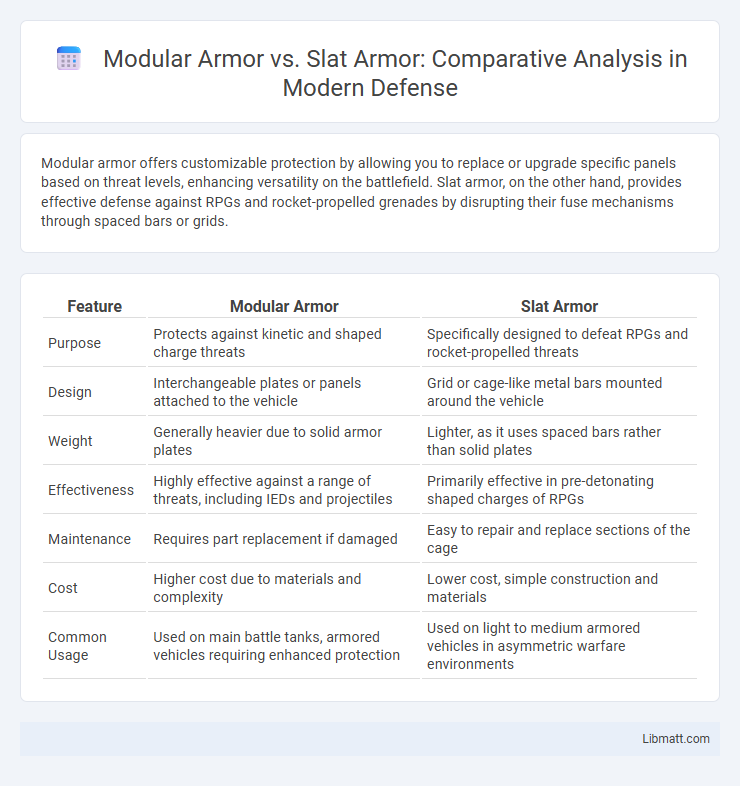Modular armor offers customizable protection by allowing you to replace or upgrade specific panels based on threat levels, enhancing versatility on the battlefield. Slat armor, on the other hand, provides effective defense against RPGs and rocket-propelled grenades by disrupting their fuse mechanisms through spaced bars or grids.
Table of Comparison
| Feature | Modular Armor | Slat Armor |
|---|---|---|
| Purpose | Protects against kinetic and shaped charge threats | Specifically designed to defeat RPGs and rocket-propelled threats |
| Design | Interchangeable plates or panels attached to the vehicle | Grid or cage-like metal bars mounted around the vehicle |
| Weight | Generally heavier due to solid armor plates | Lighter, as it uses spaced bars rather than solid plates |
| Effectiveness | Highly effective against a range of threats, including IEDs and projectiles | Primarily effective in pre-detonating shaped charges of RPGs |
| Maintenance | Requires part replacement if damaged | Easy to repair and replace sections of the cage |
| Cost | Higher cost due to materials and complexity | Lower cost, simple construction and materials |
| Common Usage | Used on main battle tanks, armored vehicles requiring enhanced protection | Used on light to medium armored vehicles in asymmetric warfare environments |
Introduction to Vehicle Armor Technologies
Modular armor offers customizable protection by allowing additional armor plates to be attached or replaced based on threat levels, enhancing vehicle adaptability and mission-specific defense. Slat armor, designed primarily to counter RPGs and shaped-charge warheads, features spaced metal bars that disrupt the detonation of incoming rounds before they reach the vehicle's hull. Your choice between modular and slat armor depends on the operational environment and the types of threats your vehicle is most likely to encounter.
What is Modular Armor?
Modular armor consists of interchangeable protective plates that can be added or removed based on mission requirements, providing customizable defense on military vehicles. This design enhances adaptability against various threats such as ballistic impacts or explosive devices, increasing overall survivability. Your choice of modular armor allows for rapid upgrades or repairs in the field, optimizing protection without the need for extensive vehicle redesigns.
What is Slat Armor?
Slat armor, also known as cage armor, consists of a framework of metal bars designed to protect vehicles from rocket-propelled grenades (RPGs) by disrupting the warhead's fuse mechanism. This type of armor is lighter and more cost-effective compared to traditional modular armor, making it suitable for quick deployment on military vehicles. Your choice between modular and slat armor should consider threat type, vehicle weight, and mission requirements.
Key Differences: Modular Armor vs Slat Armor
Modular armor consists of interchangeable, customizable panels designed to provide tailored protection against specific threats such as IEDs, small arms fire, and shrapnel, enhancing vehicle adaptability in various combat scenarios. Slat armor, also known as cage armor, employs a metal grid framework intended to detonate or disable RPG warheads before impact, mainly preventing shaped charge penetration. The key difference lies in modular armor's flexibility and focused defense capabilities compared to slat armor's simple, physical barrier effective primarily against rocket-propelled grenades.
Protection Capabilities Comparison
Modular armor offers adaptable protection by allowing layers to be added or removed based on specific threat levels, effectively neutralizing high-velocity projectiles and explosive fragments. Slat armor specializes in deflecting rocket-propelled grenades and shaped charges by disrupting their fuzing mechanisms before impact, reducing penetration risk. Your choice between modular and slat armor should consider the type of threats predominant in your operational environment for optimal defense efficiency.
Weight and Mobility Considerations
Modular armor offers significant advantages in weight management by allowing the removal or addition of specific panels, enhancing your vehicle's mobility without compromising protection where it's most needed. Slat armor, while heavier and bulkier due to its rigid metal grating design, primarily provides defense against rocket-propelled grenades but can restrict movement and increase vehicle weight substantially. Choosing modular armor optimizes the balance between protection and agility, crucial for operations requiring rapid maneuverability.
Cost and Maintenance Factors
Modular armor generally incurs higher initial costs due to its advanced materials and customizable design, but offers easier maintenance through replaceable panels, reducing long-term expenses. Slat armor features lower upfront costs and simpler construction, yet may require more frequent repairs or replacements after impact, increasing operational maintenance. Your choice depends on balancing budget constraints against the need for efficient upkeep and durability in varying combat conditions.
Operational Deployment Scenarios
Modular armor is ideal for operational deployment scenarios requiring rapid adaptability and customization to diverse threat environments, allowing you to configure protection levels based on mission-specific needs. Slat armor excels in countering rocket-propelled grenade (RPG) attacks during urban and convoy operations, providing a robust physical barrier that disrupts and neutralizes explosive projectiles. Both armor types enhance vehicle survivability, but selecting the appropriate system depends on the nature of threats and operational context.
Recent Advances and Hybrid Solutions
Recent advances in modular armor have enhanced adaptability and weight efficiency by integrating lightweight composites and reactive materials, improving protection against kinetic and shaped charge threats. Slat armor innovations focus on optimized spacing and reinforced grid designs to effectively disrupt RPG and missile attacks while maintaining mobility. Hybrid solutions combine modular panels with slat frameworks, offering comprehensive defense by balancing flexibility, coverage, and resistance to diverse battlefield threats, ensuring Your vehicle protection meets the evolving demands of modern warfare.
Choosing the Right Armor for Modern Combat
Modular armor offers customizable protection levels with adaptable panels that can be tailored to specific mission threats, enhancing soldier mobility and situational awareness. Slat armor provides effective defense against RPG and rocket-propelled grenade attacks by using a rigid grid design to disrupt the projectile's impact and detonation. Selecting the right armor depends on the balance between threat type, operational environment, and required flexibility, where modular armor suits diverse, evolving threats while slat armor excels in countering heavy anti-vehicle ordnance.
modular armor vs slat armor Infographic

 libmatt.com
libmatt.com